Introduction
Free radicals can increase oxidative stress, a factor in the development of degenerative diseases like diabetes and hypertension1. To reduce oxidative damage, people can consume dietary antioxidants such as red palm oil (RPO). The amount of carotenoid pigment in RPO is high at 600 to 1000 ppm2. RPO has 500–700 ppm of carotenes3 like beta-carotene (pro-vitamin A). RPO also contains vitamin E (560–1000 ppm). “Vitamin E” refers to four groups of tocopherols (α-, β-, γ-, and δ-tocopherols) and also four group of tocotrienols (α-, β-, γ-, and δ-tocotrienols). Vitamin E has antioxidant properties, increases hepatocellular function, and lowers plasma glucose levels2. In RPO, the forms of Vitamin E include tocopherol (18–22%), tocotrienol (78–82%), and lycopene (18.5–38 ppm)4. The most potent fat-soluble antioxidant is alpha-tocopherol2. Tocopherol functions as an antioxidant and a free radical scavenger, and α-tocopherol breaks radical chains5. Although tocotrienols have less oral bioavailability than tocopherols, they have superior antioxidant action6. Compare to tocopherol, the antioxidant properties of tocotrienol is more effective. Tocotrienol have unsaturated side chain, which can penetrate molecules more deeply and facilitate better penetration. The tocotrienol in RPO reduced oxidative stress, dyslipidemia, and blood glucose in diabetic rats7.
To increase RPO consumption, RPO can be added to a widely consumed product like coconut sugar. Coconut sugar is formed by evaporating coconut sap8. When 0.3% RPO was added during the latter stages of processing, coconut sugar solidified at 118oC. RPO did not change the product’s sensory qualities (acceptance of taste and texture as well as overall acceptance). The final product contained between 1337µg and 3946µg of β-carotene per 100g. Intervention of the product for two weeks on rats can increased the reserves of liver retinol (as a vitamin A status indicators) beyond the cut-off point value. Immunoglobulin G (a measure of heightened immunological function) increased nearly threefold9. Additionally, feeding coconut sugar supplemented with RPO can improve the weight gain of vitamin A-depleted rats10.
Coffee beans contain polyphenols, alkaloids, tannins, and saponins21. In addition, they contain minor amounts of lignans and anthocyanins23. Robusta coffee beans contain chlorogenic acid, which has a concentration of 9.0%23. The two polyphenols found in coffee in the highest concentrations are chlorogenic acid and caffeic acid; 90% of all the phenol in coffee is made up of chlorogenic acid22. Chlorogenic acids (CGAs) contain antioxidant, anti-inflammatory, antidiabetic, anti-obesity, hepatoprotective, antibacterial, and anti-hypertensive activities26. In addition to chlorogenic acid (8.7 – 11.7%), coffee beans contain antioxidant compounds such as phenolic compound of 36.26 up to 351.35 mg GAE/g, flavonoids of 13.74 up to 104.05 mg QE/g, FRAP of 30.30 up to175.89 mg GAE/g, ABTS of 14.45 up to 42.65%, and DPPH percentage inhibition of 92.23 up to 95.39%15,16. These substances have health benefits; drinking green and light coffee extracts helps to slow the growth of prostate cancer tumours17. Thus, the creation of coffee beverages high in antioxidants could help meet antioxidant demands, particularly among smokers.
An antioxidant-rich instant coffee beverage made with coconut sugar and RPO (ICB) could reduce the oxidative stress from cigarette smoke and prevent degenerative diseases. The nutrient-rich RPO would also increase the competitive value and use value of coconut sugar. This study examined the effect of different concentrations of RPO and coffee powder on the antioxidant properties of an ICB.
Materials and Methods
Study Design
This experimental study was conducted at Food Technology Laboratory at University of Jenderal Soedirman in Purwokerto, Indonesia. A completely randomised design was used. The ICB was made with coconut sugar and different concentrations of RPO and coffee. The first factor was the RPO addition at levels of 0.3%, 0.4%, and 0.5%. The second factors were coffee powder addition of 6%, 8%, and 10%. The ICBs were created and tested three times.
The parameters observed were: DPPH inhibition percentage using spectroscopy, total tocopherol using HPLC11, total phenol using spectrophotometry12, beta-carotene using HPLC at 450 nm wavelength13, and water content using the gravimetric method13.
Sample Preparation
The coffee was obtained from the powdered coffee industry in Purwokerto, Central Java, Indonesia. It was sifted using a sieve with a mesh size of 80.
The ICB was made by modifying the process of producing coconut sugar from coconut sap by replacing vegetable oil with RPO:
Purification of coconut sap: Coconut sap was acquired by “tapping” palm flowers. The coconut sap was cleansed of contaminants using a staged process that included 60 mesh filtrations, boiling, and cooling. The precipitate was obtained by decantation. In a final purification step, re-filtration was performed with a 200-mesh filter.
Cooking the coconut sap: After measuring the pH and Brix level of clean coconut sap, the sap was cooked. RPO was added (0.3%, 0.4%, 0.5% in accordance with the planned treatments) once the temperature reached 102°C. Next, the coffee powder was added in accordance with the predetermined treatments (6%, 8%, 10%).
The amounts of RPO and coffee powder were corrected by the Brix degrees of the sap at 20oBrix . The equation was:

The mixture was stirred continuously. Heating was stopped when the cooking temperature reached 1190C . The solidification stages followed. The stirring was done continuously until a semi-solid mass formed. Finally, the substance was ground and sifted through a 16-mesh screen to create coffee granules.
Tocopherols Assays
Tocopherol extraction was performed with minor modifications to the procedures of Pertuzatti et al11. Cold acetone were used to obtained the ICBs’extracts and than mixed with petroleum ether. Than followed with centrifuged at 9000 rpm for 10 min after the ethereal phase was separated and after that transferred to a vial of 1.5mL for analysis of tocopherol.
A high-performance liquid chromatography system (SHIMADZU, Kyoto, Japan) was used to performed the tocopherols identification and quantification. The system consisting of an LC-10ATVP delivery pump of solvent, column oven, degasser of FCV-10ALVPc, the rheodyne pump of DGU-14A, the SCL-10AVP, CTO-10ASVP, , and a SIL-10AF autosampler. The analytical reversed phase column was used in performed chromatographic separation, Shim-Pak CLC-ODS (4.6 mm x 150 mm x 4 mm), and the stationary phase used was the octadecil groups. Used a wavelength of emission of 330nm and wavelength of excitation of 290nm of a fluorescence detector RF e 10AXL. Using the initial mobile phase of isopropanol/acetonitrile/methanol (10:50:40. v/v/v) for 10 minutes, a total of 10 mL of sample was injected. As linearly, a mobile phase was altered to isopropanol/acetonitrile/methanol (5:30:65, v/v/v) up passed to 12 minutes. Next, it was returned linearly to the initial mobile phase up to 15 minutes. A 1 mL per minute of constant flow was used. To identify the peak was by comparing it to the tocopherol standards. The results were expressed as g tocopherol per 100 g of coffee granule (%).
Total Phenolics Assays
Folin-Ciocalteu assay reported by Hammerschimidt & Pratt was used for determining the total phenolics12. A 0.5 mL sample of the extract was mixed with 0.5 mL of the reagent of Folin-Ciocalteu. After that, 1 mL of 7.5% Na2HCO3 solution was added to the mixture, and adjusted the volume up to 10 mL with distilled water.The mixture was vortexed for 30s and kept in a dark place for 30min. The absorbance was measured at 750nm using a UV–Vis spectrophotometer (UV-1800, Shimadzu Corporation, Japan). Total phenolics (%) was calculated with the equation:

X = total phenolics of the standard curve
V = extract volume
Fp= dilution factor
Determination of 1,1-diphenyl-2-picrylhydrazyl (DPPH) radical scavenging activity
DPPH (1,1-diphenyl-2-picrylhydrazyl) is a useful free radical for determining the activity of antioxidant of constituents in an extract. It reacts with a substance and contributes an atom of hydrogen. By taking one H atom from an antioxidant or an electron donor to generate DPPH, the DPPH radical is stabilised. The ascorbic acid equivalent is used to represent DPPH radical capture activity. Antioxidants can diminish the DPPH radical, which changes the colour of stabilised DPPH to yellow. This technique can demonstrate how the coffee beverages’ active ingredients trap DPPH radicals24.
Estimation the donation capacity of electron or hydrogen atom of ICBs was from bleaching of a purple-coloured DPPH radical methanol solution. An aliquot of the extract or GSH (400μL) (1 mg/mL) was mixed with 200μL of distilled water. After that, a total amount of 600μL of the DPPH solution in methanol of a 0.4mM was added and left in the dark for 30 min. Using a Healicom 721S (China) UV–visible spectrophotometer at 516 nm, the absorbance was taken.
The percentage inhibition of DPPH was calculated using the following equation:

Beta carotene Assays
Beta carotene content in the ICBs’ coffee granules was analysed according to AOAC methods13. A 1g sample of the coffee granules was extracted with hexane and acetone (1:1), then filtered using a Buchner funnel under vacuum. The resulting filtrate was put into a test tube to be dried with N2. The dried filtrate was added with 4 mL of 5% KOH and methanol, then shaken and aerated for 30 minutes.
The extract was heated in a water bath at 600C for 30 minutes. Next, 4 mL of deionised water and 8 mL of hexane were added. These steps were repeated with the addition of 4 mL of deionised water and 6 ml of hexane; the sample was then shaken for 1 minute, and the top layer of the extract was taken and collected. The filtrate obtained was centrifuged at 2000 rpm for 5 minutes.
The organic phase was removed and dried over N2. The dry residue was combined with 5 ml of 5% CHCl3 in methanol, then dried and aerated for 30 minutes. The extract was then allowed to stand in a cooler at -200C for 12 hours and then dried with N2. The dry residue was added with 2 ml of acetonitrile (ACN): dichloromethane: methanol (65:30:5) as the mobile phase.
The β-carotene standard was mixed in petroleum ether, evaporated, and mixed with dichloromethane. Standard concentrations were demonstrated spectrophotometrically using the Etem molar extension coefficient of 1% = 2530. Different concentrations were used for the HPLC analysis and plotting of the standard graphs. The correlation coefficient was calculated to estimate the linearity between the standard concentration and the peak area/graph. Samples were diluted for injection and separation. The analysis was related to the average solvent flow at 1.5 ml per minute with a detector sensitivity (AUES) of 0.02 and a standard wave of 450 nm using the formula:

Statistical Analysis
Data were analysed by ANOVA at the 95% confidence interval. If there were significant differences, the analysis was continued with Duncan’s multiple range test.
Results
Water content
The amounts of RPO and coffee both had a substantial impact on the water content of the ICBs. Water content increased as the amount of coffee increased. In contrast, water content decreased as RPO increased (Figure 1). The average water content of the coffee mix was 4.75% (for a coffee addition of 6%), 5.05% (for 8%), and 6.05% (for 10%). The mean water content of the coffee mix was 5.87% (for RPO of 0.3%), 5.23% (0.4% RPO) and 4.81% (0.5% RPO).
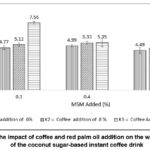 |
Figure 1: The impact of coffee and red palm oil addition on the water content of the coconut sugar-based instant coffee drink |
Table 1. The results of Parameters quantitative analysis of antioxidants properties
|
|
Total Phenolics |
Tocopherol |
DPPH% inhibition |
beta carotene |
|
M1K1 |
2.20 ± 0.325 |
0.56 ± 0.030 |
70.8±0.955 |
575.3±5.386 |
|
M1K2 |
2.44 ± 0.251 |
0.55 ± 0.0179 |
75.8±1.389 |
460.8±16.916 |
|
M1K3 |
2.44 ± 0.185 |
0.47 ± 0.0084 |
76.4±1.141 |
478.7±55.053 |
|
M2K1 |
2.49 ± 0.327 |
0.72 ± 0.0053 |
73.3±5.85 |
969.7±41.96 |
|
M2K2 |
2.88 ± 0.461 |
0.71 ± 0.0137 |
77.6±0.864 |
704.1±34.029 |
|
M2K3 |
2.91 ± 0.195 |
0.56 ± 0.0314 |
78.4±1.644 |
569.5±28.801 |
|
M3K1 |
2.47 ± 0.155 |
0.85 ± 0.0622 |
78.6±2.664 |
1256.8±67.795 |
|
M3K2 |
2.49 ± 0.335 |
0.84 ± 0.0054 |
79.5±0.407 |
997.3±49.367 |
|
M3K3 |
2.70 ± 0.308 |
0.77 ± 0.0394 |
82.1±1.630 |
750.6±34.271 |
Results are expressed as the mean ± standard error.
Total Phenolics Content
The quantity of RPO or coffee added to the ICBs had no discernible impact on total phenolics (Figure 2). Nonetheless, the average phenolics content increased in proportion to the amount of coffee added. In coffee additions of 6%, 8%, and 10%, the mean values of total phenolics were 2.38%, 2.60%, and 2.68%, respectively.
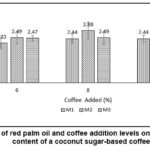 |
Figure 2: Effect of red palm oil and coffee addition levels on total phenolics content of a coconut sugar-based coffee drink |
Antioxidant Activity (DPPH inhibition percentage)
Figure 3 illustrates how the ICB can scavenge DPPH radicals. The antioxidant activity of the ICBs was significantly affected by the addition of coffee powder and RPO. The antioxidant activity increased with the addition of coffee or RPO. The mean DPPH inhibition percentages after adding 0.3%, 0.4%, and 0.5% of RPO were 74.34%, 77.62%, and 80.05%, respectively. The mean DPPH inhibition percentages after adding 6, 8, and 10 % of coffee were 74.25%, 77.62%, and 78.95%, respectively (Figure 3).
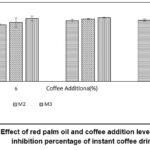 |
Figure 3: Effect of red palm oil and coffee addition levels on DPPH inhibition percentage of instant coffee drink |
Tocopherol Content
The amount of RPO or coffee considerably affected the total tocopherol content of the ICBs. Mean tocopherol content ranged from 0.47% to 0.85%. Total tocopherol content increased as more RPO was added. On the other hand, tocopherol content decreased as more coffee was added (Fig 4). After the addition of 0.3%, 0.4%, and 0.5% RPO, the total tocopherol content (vitamin E) of the ICB was 0.526%, 0.664%, and 0.819, respectively. However, the total tocopherol after the addition of 6%, 8%, and 10% of coffee was 0.708%, 0.702%, and 0.599%. The amount of tocopherol increased as RPO increased or as coffee decreased.
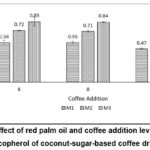 |
Figure 4: Effect of red palm oil and coffee addition levels on total tocopherol of coconut-sugar-based coffee drink |
Beta-carotene Content
The amount of both RPO and coffee and their interaction had a significant effect on the amount of beta-carotene in the ICBs. The amount of beta-carotene in the product increased as more as RPO was added. On the other hand, beta-carotene decreased as more coffee was added (Fig 5). Average beta-carotene in the ICBs treated with 0.3%, 0.4%, and 0.5% RPO was 504.93 µg/100 g, 747.79 µg/100 g, and 1001.17 µg/100 g, respectively. The average beta-carotene after adding 6%, 8%, and 10% coffee was 933.93 µg/100 g, 720.74 µg/100 g, and 599.62 µg/100 g, respectively.
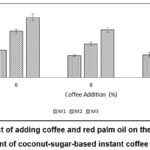 |
Figure 5: Effect of adding coffee and red palm oil on the beta-carotene content of coconut-sugar-based instant coffee drinks |
There was a decrease in the number of components (including the beta-carotene content) present per unit weight with the rise in the amount of coffee added. This decrease appeared to be related to the enhanced yield that was consistent with the increase in coffee added during the process.
Discussion
Most smokers are also coffee drinkers. In addition to chlorogenic acid (8.7 – 11.7%), coffee beans contain antioxidant compounds such as phenolic compound (36.26 up to 351.35 mg GAE/g), ABTS (14.45 up to 42.65%), flavonoids (13.74 up to 104.05 mg QE/g), and DPPH (92.23 up to 95.39%), FRAP (30.30 up to175.89 mg GAE/g)15,16. Drinking green and light coffee extracts helps to slow the growth of prostate cancer tumours17. Thus, the creation of coffee beverages high in antioxidants could help meet antioxidant demands, particularly among smokers.
When more coffee powder was added in this study, the ICBs’ moisture content increased. The method for generating ICBs involved vaporizing coconut sap and adding different concentrations of RPO and coffee. Coffee has a fibre that is hydrophilic (or easily binds water)18. Coffee contains crude fibre of 8.25–10.6416. The presence of coffee would make some water in the coconut sap bind the fibre, inhibiting the evaporation process of coconut sap. As a result, the finished product would include more water when more coffee was added.
On the other hand, the ICBs’ moisture content decreased as RPO increased. The presence of oil in a solution system accelerates the evaporation of the water and enhances the amount of heat received by the system. Oil dissipates heat more effectively than water because it heats up more quickly and has a lower heat type. In this study, RPO replaced oil. RPO aids heat transfer into the material; thus, with more RPO, water release was faster. Although oil heats up more quickly than water and has a lower heat type, oil has a better heat dissipation mechanism20. Thus, the rate of water evaporation increased with the addition of more RPO19.
This research revealed that the amount of RPO or coffee had no discernible impact on the total phenol content of the ICBs. Nonetheless, phenol content on average overall was higher (not significant) with increased coffee. On the other hand, the addition of RPO or coffee boosted antioxidant activity. The total tocopherol content was significantly influenced by the amount of RPO or coffee added. RPO increased vitamin E. These findings are consistent with the high nutrient content of both coffee and RPO as described earlier2,4,5,21-24
Beta-carotene levels in the ICBs increased with the addition of RPO and fell with the addition of coffee. The RPO utilised in this study had a beta-carotene content of 806.210 ppm, according to the analysis. As a result, adding more RPO raised the product’s beta-carotene content.
DPPH (1,1-diphenyl-2-picrylhydrazyl) is a free radical that is useful for determining the antioxidant activity of constituents in an extract. It reacts with a substance and contributes an atom of hydrogen in the process. By taking one H atom from an antioxidant or an electron donor to generate DPPH, the DPPH radical is stabilised. The ascorbic acid equivalent is used to represent DPPH radical capture activity. Antioxidants can diminish the DPPH radical, which changes the colour of stabilised DPPH to yellow.
Conclusion
The final ICB produced in this investigation had a water content of 5.33%, beta carotene of 704.83 g/100 g, total phenol of 2.88%, antioxidant activity (DPPH inhibition percentage) of 77.55%, and tocopherols (vitamin E) of 0.71%. The addition of 0.4% RPO and 8% coffee powder produced the best chemical characteristics. People who frequently encounter free radicals, including smokers, may benefit from an ICB fortified with RPO antioxidants and coffee powder.
Acknowledgement
The authors would like to thank our research team which has provided help during the work.
Funding Sources
The Directorate of Research and Community Service financially supporting the present work through the Funded Research Through Grants scheme (grant no.:059/SP2H/LT/DRPM/2018).
Conflict of Interest
There is no conflict of interest
with any party.
References
- Kamen C., Blosnich J.R., Lytle M., Janelsins M.C., Peppone L.J., Mustian K.M. Cigarette Smoking Disparities Among Sexual Minority Cancer Survivors. Preventive Medicine Reports Jour. 2015; 2: 283–286.
CrossRef - Lee G.Y., Han S.N. The Role of Vitamin E in Immunity. Nutrients Jour. 2018; 10: 1–18.
CrossRef - Harlen C.W., Muchtadi T.R., Palupi N.S. β-Carotene Bioavailability of Palm Oil Emulsion Drink in Rats (Rattus norvegicus) Blood Plasma and Liver. International Food Research Jour. 2018; 25: 1349–1356.
- Sulihatimarsyila N.A.W., Lau H.L.N., Nabilah K.M., Azreena N.I. Production of Refined Red Palm-Pressed Fibre Oil from Physical Refining Pilot Plant. Case Studies in Chemical and Environmental Engineering Journal. 2020; 2(100035): 1-8
CrossRef - Emmanuel O., Okezie U.M., Iweala E.J., Ugbogu E.A. Pretreatment of Red Palm Oil Extracted from Palm Fruit (Elaeis Guineensis) Attenuates Carbon Tetrachloride Induced Toxicity in Wistar Rats. Phytomedicine Plus Jour. 2021; 1: 100079.
CrossRef - Yoshida, Y., Niki, E., Noguchi, N. Comparative study on the action of tocopherols and tocotrienols as antioxidant: chemical and physical effects. Chemistry and Physics of Lipids Jour. 2003. 123 (Issue 1):63-75
CrossRef - Sulaiman N.S., Sintang M.D., Mantihal S., Zaini H.M., Munsu E., Mamat H., Kanagaratnam S., Jahurul M.H.A., Pindi W. Balancing Functional and Health Benefits of Food Products Formulated with Palm Oil as Oil Sources. Heliyon Jour. 2022; 8(e11041): 1-11.
CrossRef - Khongsak S., Sangkhiaw J., Likittrakulwong W. Productions and Functional Properties of Palm Sugars. Walailak Journal of Science and Technology. 2018; 16: 897–907.
CrossRef - Dwiyanti H., Riyadi H., Rimbawan R., Damayanthi E., Sulaeman A., Handharyani E. Effect of Feeding Palm Sugars Enriched with CPO and RPO on Liver Retinol and IgG Concentration of Vitamin A Depletion Rats. Pakistan Journal of Nutrition. 2013; 12: 1042–1049.
CrossRef - Dwiyanti H., Riyadi H., Rimbawan R, Damayanthi E., Sulaeman A. The Addition of CPO and RPO as a Source of Provitamin A on Carotene Retention, Physical Properties and Acceptance of Coconut Sugar. Agricultural Industry Technology Jour. 2014; 24: 28–33.
- Pertuzatti, P. B., Sganzerla, M., Jacques, A. C., Barcia, M. T., & Zambiazi, R. C. Carotenoids, tocopherols and ascorbic acid content in yellow passion fruit (Passiflora edulis) grown under different cultivation systems. LWT – Food Science and Technology Jour, 64(1), 259–263.
CrossRef - Hammerschmidt, P.A. & Pratt, D.E. 1978. Phenolic antioxidant of dried soybean. Journal Food Science, 43: 556-559
CrossRef - AOAC. Official Methods of Analysis of the Association of Official Agricultural Chemists International. The Association of Official Agricultural Chemists Jour. 2005; 41: 12.
- Kamceva, G., Sarafinovska, Z.A., Ruskovska, T., Zdravkovska, M., Panova, L.K., Stikova, E. Cigarette Smoking and Oxidative Stress in Patients with Coronary Artery Disease. Medical Sciences Jour. 2016; 4(4): 636-640.
CrossRef - Lemos M.F., de Andrade S.N., de Souza C.M.M., Lirio K., da Fonseca A.F.A., Pacheco H.P., Endringer D.C., Fronza M., Scherer R. Chlorogenic Acid and Caffeine Contents and Anti-Inflammatory and Antioxidant Activities of Green Beans of Conilon and Arabica Coffees Harvested with Different Degrees of Maturation. Saudi Chemical Society Jour. 2022; 26:1–11.
CrossRef - Agunbiade H.O, Fagbemi T.N., Aderinola T.A. Antioxidant Properties of Beverages from Graded Mixture of Green/Roasted Coffee and Hibiscus Sabdariffa Calyx Flours. Applied Food Research Jour. 2022; 2 (Issue 2): 1-8
CrossRef - Montenegro J., Santos L.S., de Souza R.G.G., Lima L.G.B., Mattos D.S., Viana B.P.P.B., Bastos A.C.S.F., Muzzi L., Conte-Júnior C.A., Gimba E.R.P., Silva O.F., Teodoro A.J. Bioactive compounds, antioxidant activity and antiproliferative effects in prostate cancer cells of green and roasted coffee extracts obtained by microwave-assisted extraction (MAE). Food Research International Jour. 2021; 140(110014): 1-12
CrossRef - Kusumah J., Mejia E.G. Coffee Constituents with Antiadipogenic and Antidiabetic Potentials: A narrative review. Food and Chemical Toxicology Jour. 2022; 161: 1–11
CrossRef - Asghar M.T., Yusof Y.A., Mokhtar M.N., Ya’acob M.E., Mohd. Ghazali H., Chang L.S., Manaf Y.N. Coconut (Cocos nucifera L.) Sap as a Potential Source of Sugar: Antioxidant and nutritional properties. Food Science and Nutrition Jour. 2020; 8: 1777–1787.
CrossRef - Oke E.K., Idowu M.A., Sobukola O.P., Adeyeye S.A.O., Akinsola A.O. Frying of food: a critical review. Culinary Science and Technology Jour. 2018; 16: 107-127
CrossRef - Brzezicha J., Błażejewicz D., Brzezińska J., Grembecka M. Green Coffee vs Dietary Supplements: A Comparative Analysis of Bioactive Compounds and Antioxidant Activity. Food and Chemical Toxicology Jour. 2021; 155: 1–12.
CrossRef - Oktaviani L., Astuti D.I., Rosmiati M., Abduh, M.Y. Fermentation of Coffee Pulp Using Indigenous Lactic Acid Bacteria with Simultaneous Aeration to Produce Cascara with a High Antioxidant Activity. Heliyon Jour. 2020; 6: e04462.
CrossRef - Han I., Lee C.S. Quality Properties and Bioactivities of American Cookies with Coffee Extract Residues. LWT- Food Science and Technology Jour. 2021; 151: 112173.
CrossRef - Evary Y.M., Nugroho A.E., Pramono S. Comparative Study on DPPH Free Radical Scavenging and Alpha-Glucosidase Inhibitory Activities of Ethanolic Extracts from Different Parts of Durian Plant (Durio zibethinus murr.). Food Research Jour. 2019; 3: 463–468.
CrossRef - Morcillo F., Vaissayre V., Serret J., Avallone S., Domonhédo H., Jacob F., Dussert S. Natural diversity in the carotene, tocochromanol and fatty acid composition of crude palm oil. Food Chemistry Jour. 2021; 365: 130638
CrossRef - Tucker J.M., Townsend D.M. Alpha-tocopherol: Roles in Prevention and Therapy of Human Disease. Biomedicine & Pharmacotherapy Jour. 2005; 59: 380–387.
CrossRef - Perez-Ternero C., Alvarez de Sotomayor M., Herrera M.D. Contribution of ferulic acid, γ-oryzanol and tocotrienols to the cardiometabolic protective effects of rice bran. Functional Foods Jour. 2017; 32: 58–71
CrossRef - Naveed, M., Hejazi, V., Abbas, M., Kamboh, A. A., Khan, G. J., Shumzaid, M.,XiaoHui, Z. Chlorogenic acid (CGA): A pharmacological review and call for further research. Biomedicine and Pharmacotherapy Jour. 2018; 97:67–74. https://doi.org/10.1016/j.biopha.2017.10.064.
CrossRef - Perez-Santana M., Cagampang G.B., Gu L., MacIntosh I.S., Percival S.S., MacIntosh A.J. Characterization of physical properties and retention of bioactive compounds in cookies made with high oleic red palm olein. LWT – Food Science and Technology Jour. 2021; 147: 111499
CrossRef

This work is licensed under a Creative Commons Attribution 4.0 International License.







